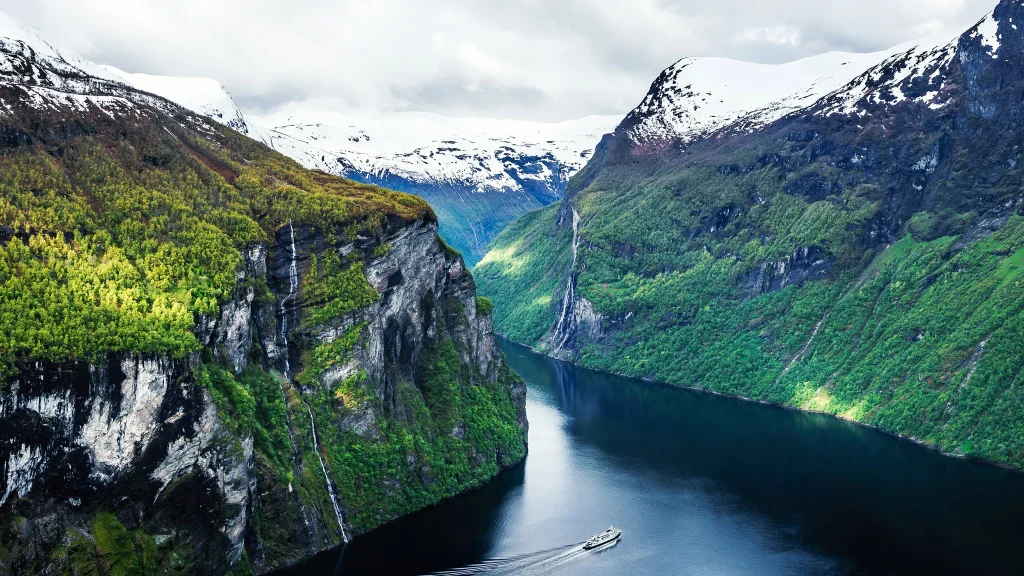Stretching along the coastlines of Norway and dipping into parts of Sweden and Denmark, the Scandinavian fjords are among the most breathtaking natural wonders on Earth. Carved by glaciers over millions of years, these deep, narrow inlets are surrounded by towering cliffs, lush greenery, and cascading waterfalls. Visiting the fjords is not just about admiring their beauty; it’s about yourself in their rich history, geology, and the local cultures that around them.
This guide will take you through the wonders of the Scandinavian fjords, uncovering must-visit destinations, activities, and tips for an unforgettable journey.
1. What Are Fjords? A Glimpse Into Their Geological Marvel
Fjords are created by glacial activity. As glaciers carve their way through valleys, they leave behind steep cliffs and deep basins. When the glaciers melt, seawater floods these valleys, creating the stunning fjords we see today. Norway alone is home to over 1,000 fjords, with some extending over 200 kilometers inland.
Fjords aren’t just geological formations; they are ecosystems teeming with marine life, including seals, porpoises, and fish. The surrounding forests and cliffs are habitats for diverse wildlife, from eagles to mountain goats.
2. Famous Fjords of Scandinavia
Geirangerfjord (Norway)
- Why Visit: Geirangerfjord is often called the jewel of Norway, with UNESCO World Heritage status for its stunning beauty. Surrounded by sheer cliffs, it’s known for its dramatic waterfalls, including the “Seven Sisters” and “The Suitor.”
- Activities:
- Take a boat tour to admire the waterfalls up close.
- Hike to viewpoints like Dalsnibba or Flydalsjuvet for panoramic vistas.
- Kayak through the tranquil waters for a more intimate experience.
Sognefjord (Norway)
- Why Visit: Known as the “King of Fjords,” Sognefjord is the longest and deepest fjord in Norway, stretching over 200 kilometers inland.
- Activities:
- Visit Flåm, a charming village at the fjord’s end, and ride the Flåm Railway, one of the most scenic train journeys in the world.
- Explore Nærøyfjord, a narrow arm of Sognefjord, also a UNESCO World Heritage Site.
- Discover stave churches, like Urnes Stave Church, an architectural masterpiece.
Lysefjord (Norway)
- Why Visit: Lysefjord is famous for its iconic hiking trails, including the challenging trek to Kjeragbolten, a boulder wedged between two cliffs, and the more accessible Preikestolen (Pulpit Rock).
- Activities:
- Hike to Preikestolen for jaw-dropping views of the fjord below.
- Take a guided climbing expedition to Kjeragbolten.
- Experience a high-speed RIB (rigid inflatable boat) tour.
Hardangerfjord (Norway)
- Why Visit: Known as the “Orchard of Norway,” Hardangerfjord is famous for its fruit trees that blossom in spring and its proximity to the Folgefonna Glacier.
- Activities:
- Walk along the Hardangerfjord Route to discover local farms and cideries.
- Visit Vøringsfossen, one of Norway’s most famous waterfalls.
- Explore Folgefonna National Park, where you can hike or even try glacier skiing.
3. Activities to Experience the Fjords
a. Boat Tours and Cruises
Cruising is one of the best ways to explore the fjords. From luxurious multi-day cruises to small boat tours, you’ll experience the sheer scale of the cliffs, spot wildlife, and glide past hidden waterfalls. Many cruises include stops at small villages, where you can yourself in local culture.
b. Hiking Trails
The fjords are surrounded by some of the most scenic hiking trails in the world.
- Moderate Hikes: Trolltunga (Troll’s Tongue) near Hardangerfjord offers a 22-kilometer round trip with views that are worth every step.
- Easy Walks: Briksdal Glacier near Nordfjord offers short trails leading to the foot of a stunning glacier.
c. Kayaking and Paddleboarding
For a more serene experience, kayaking allows you to glide through the still waters, exploring hidden nooks of the fjords. Guided tours are available for beginners and seasoned paddlers alike.
d. Fishing and Wildlife Watching
Fishing in the fjords is a time-honored tradition. Whether it’s casting a line for cod or spotting seals and porpoises, the fjords are a haven for nature enthusiasts. Birdwatchers can also look for white-tailed eagles and puffins.
e. Visiting Local Villages
Many fjords are home to charming villages, where life moves at a slower pace.
- Aurland: Known for its traditional crafts and breathtaking views.
- Balestrand: A picturesque village along Sognefjord with art galleries and local eateries.
- Undredal: Famous for its goat cheese production and a stave church dating back to the 12th century.
4. Scandinavian Culture Around the Fjords
The communities around the fjords are deeply connected to the land and sea. Traditional Norwegian culture emphasizes sustainability and harmony with nature.
- Cuisine: Savor local dishes like smoked salmon, reindeer stew, and cloudberry desserts. Fjord trout is a delicacy often prepared fresh from the waters.
- Festivals: Summer months bring festivals celebrating local heritage, including boat regattas, traditional music, and folk dancing.
- Myths and Folklore: The fjords are steeped in Norse mythology. Tales of trolls, giants, and mythical creatures are an integral part of the region’s storytelling traditions.
5. When to Visit the Fjords
The fjords are a year-round destination, but your experience will vary depending on the season.
- Summer (June–August): The warmest and most popular time to visit, perfect for hiking and outdoor activities. The days are long, with the Midnight Sun phenomenon in northern regions.
- Spring (April–May): A magical time when flowers bloom, waterfalls swell with melted snow, and fruit orchards come alive.
- Fall (September–October): Fewer crowds and stunning fall foliage make this a peaceful time to explore.
- Winter (November–March): While many activities slow down, winter offers a chance to see the fjords under a blanket of snow. Northern Lights tours and cozy villages make for a unique winter escape.
6. Practical Tips for Exploring the Fjords
- Transportation: Renting a car allows you to explore at your own pace, but public transport options like ferries and trains are also excellent.
- Packing Essentials: Bring sturdy walking shoes, waterproof clothing, and layers for varying weather conditions.
- Sustainability: Respect the natural environment by adhering to local guidelines, minimizing waste, and supporting eco-friendly tours.
- Guided vs. Independent Travel: Guided tours provide insights into the history and geology of the fjords, while independent travel allows more flexibility.
Conclusion: The Timeless Allure of the Fjords
The Scandinavian fjords are more than just natural wonders—they are a testament to the power of nature and its ability to inspire awe. Whether you’re cruising through Geirangerfjord, hiking the trails around Lysefjord, or exploring the charming villages along Sognefjord, each experience feels like stepping into a living postcard.
A visit to the fjords is not only a journey through dramatic landscapes but also an opportunity to connect with Scandinavian culture, history, and traditions. Prepare to leave with a heart full of memories and a newfound appreciation for the untamed beauty of the North.

